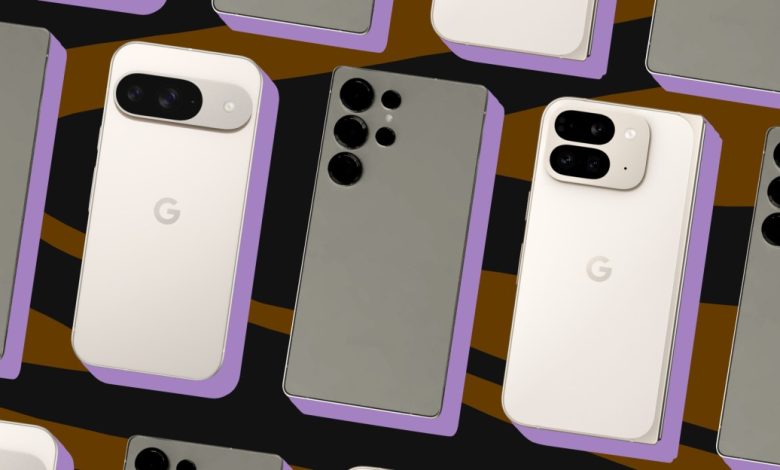The best Android phones to buy in 2025

The Android ecosystem is all about choice. While iPhone owners have a smaller pool of new devices to pick from when it’s time to upgrade, there’s a wider range of choices on Android. Some Android phones even fold in half! Imagine.
On the flip side, all that choice can make for some hard decisions. Here’s where I’d like to help; I’ve tested a whole boatload of recent Android phones, and I think there are some real winners in the current batch. It’s all a matter of what you’re looking for, what you’re comfortable spending, and what your definition of a “reasonably sized phone” is. (I have my own, personally.)
As you sift through the options, you’ll almost certainly come across tech’s favorite buzzphrase of the year: AI. Generally speaking, AI has yet to really impress me on a phone. The Pixel 9 series has some potentially useful features, like a new Screenshots app that uses AI to tag relevant info in metadata, and Galaxy devices can translate a phone call for you in real time. These things are nothing to sneeze at! But none of it feels like the platform shift that the big tech companies keep promising. Best not to put too much stock in any company’s AI claims just yet.
What I’m looking for
A great Android phone will go the distance. I look for signs that the hardware and software will keep up for many years to come, including a strong IP rating for dust and water resistance (IP68 is preferred), durable glass panels on the front and back, and a sturdy aluminum frame rather than plastic. Samsung and Google flagships now offer seven years of OS and security updates, which as awesome. As a bare minimum three years of Android OS version upgrades is preferred, along with a total of four or five years of security updates.
The best Android phones have plenty of resolution to cover their large display area, which means 1440p, ideally. A fast refresh rate of at least 120Hz is preferred — animations and scrolling look super smooth at that rate — and even better if it’s variable down to 1Hz to save on battery life.
Any phone can take a decent photo in good lighting, but the best phone cameras can handle low light and high-contrast scenes well, too. I look for optical (most common) or sensor-shift (rare) image stabilization, which helps compensate for hand shake and enable slower shutter speeds in low light to gather more light. A telephoto lens is great to have too, though high-res sensors are starting to offer better lossless crop modes that mimic short zoom lenses well.
Most phones on this list offer wireless charging, though not all do. Lack of wireless charging isn’t a complete deal-breaker, but it’s becoming an essential feature for a lot of people since it’s convenient for charging many different kinds of devices.
If you live in the US, I have some bad news about the Android market, though. For complicated reasons having to do with “capitalism” and “geopolitics,” we don’t get nearly as many of the options as you’ll find in Asia and Europe — brands like Huawei, Xiaomi, Honor, and Oppo just aren’t available here. I’ve limited this guide to the devices I’ve personally tested in depth; thus, it is a fairly US-centric set of recommendations.
With that in mind, it’s also worth acknowledging that most people in the US get their phones “for free” from their wireless carrier. If you can manage it, buying a phone unlocked will give you the most flexibility and freedom if you end up wanting to change carriers in the near future. Phone manufacturers also offer financing and trade-in deals to make payment more manageable. But if you’re happy with your carrier and the free phone on offer is the one you really want, by all means, take the free phone. Just make sure you understand the terms, especially if you need to change plans to cash in on the deal.
However you go about it, you have some fantastic options for your next Android phone.
The best Android phone overall
Screen: 6.3-inch 1080p 120Hz OLED / Processor: Tensor G4 / Cameras: 50-megapixel f/1.7 main with OIS, 48-megapixel ultrawide, 10.5-megapixel selfie / Battery: 4,700mAh / Charging: 27W wired, 15W wireless (with Pixel Stand 2) / Weather resistance: IP68
Google’s hardware is better than ever, and the whole Pixel 9 lineup feels just as polished as anything you’d get from Samsung or Apple. But at $799, the basic Pixel 9 is in a particularly appealing position, and if you don’t need a telephoto camera or the biggest screen, then this is the Android phone to get.
The Pixel 9 comes with some significant quality-of-life improvements like a faster fingerprint scanner for unlocking the phone. The camera is as reliable as ever, and if you’re into AI photo editing tricks, boy does this phone have ‘em. There’s a new Screenshots app that acts as a place to store all of the information that would otherwise be lost at sea in your camera roll, and it uses AI to parse information out and make it searchable. Kinda handy.
Even without AI, this is an excellent phone. It’s also designed to go the distance, with seven years of promised OS updates, which very likely means you’ll outgrow the phone before Google stops supporting it. Its potential for long-term value and the quality of the hardware make it an easy recommendation for anyone who just wants a nice Android phone that works.
The best maximalist phone
Screen: 6.9-inch 1440p 120Hz OLED / Processor: Qualcomm Snapdragon 8 Elite / Cameras: 200-megapixel main with OIS, 50-megapixel 5x telephoto with OIS, 10-megapixel 3x telephoto with OIS, 50-megapixel ultrawide, 12-megapixel selfie / Battery: 5,000mAh / Charging: 45W wired, 15W wireless (Qi2 Ready) / Weather resistance: IP68
There’s still no phone quite like the Ultra. The Galaxy S25 Ultra is Samsung’s latest answer to the question, “What if your phone had all of the features?” It’s equipped with two telephoto cameras, a built-in stylus, and a big, bright screen. Good luck finding that combination in another phone. Related: this is one of the most expensive slab-style phones you can buy.
The newest edition of the Ultra comes with rounded corners and flat edges, making it more comfortable in your hand. But if you’re looking for significant year-over-year improvements to the Ultra formula outside of that, well, you won’t find much. Samsung’s focus has been on software features, which is to say AI features. But AI on Galaxy phones remains a mixed bag — it’s certainly not the paradigm shift Samsung wants us to think the S25 series represents.
All of that puts the Ultra in a place of slightly less distinction than previous versions. The biggest updates are software features available to the rest of the S25 series. The Ultra looks and feels more like other Galaxy phones this time around, too. More than ever, it’s hard to understand what Samsung means when it calls this phone “Ultra.” Still, it’s your best choice for a feature-packed Android phone — even if it’s not quite as ultra as it once was.
The best phone if you hate waiting for your phone to charge
Screen: 6.82-inch 1440p 120Hz LTPO OLED / Processor: Snapdragon 8 Elite / Cameras: 50-megapixel f/1.6 main with OIS, 50-megapixel 3x telephoto with OIS, 50-megapixel f/2.0 ultrawide, 32-megapixel selfie / Battery: 6,000mAh / Charging: 80W wired, 50W wireless / Weather-resistance rating: IP68 and IP69
There are plenty of good reasons to consider the OnePlus 13. It has a big, beautiful screen, and costs a hundred bucks less than the Galaxy S25 Plus. Its dust and water resistance is so strong you could practically use the phone in a hurricane without consequences. And its camera system is much improved year over year, particularly when it comes to low-light portraiture. But there’s one standout reason to consider the 13: impatience.
The OnePlus 13 offers enough battery stamina to get through two days of moderate use on a single charge — and that’s with plenty of power-draining features enabled, including the always-on display. If you’re thriftier with your charge, it could even go beyond that. Forgot to charge overnight? No big deal; you can probably just charge it up on night two. Charging is also relatively fast, and in the US, the phone comes with an 80W wired charger in the box. So even if you do need a midday top-off, you’ll be able to get hours of charge in a matter of minutes. No other flagship phone offers that kind of charging (or not charging) flexibility.
Screen: 8.0-inch 2076p 120Hz OLED inner screen, 6.3-inch 1080p 120Hz OLED cover screen / Processor: Tensor G4 / Cameras: 48-megapixel f/1.7 main with OIS, 10.8-megapixel 5x telephoto with OIS, 10.5-megapixel ultrawide, 10-megapixel selfie (cover screen), 10-megapixel inner selfie camera / Battery: 4,650mAh / Charging: 21W wired, 7.5W wireless / Weather resistance: IPX8
Does anyone truly need a folding phone? Probably not. But using one is awfully nice, and the Pixel 9 Pro Fold is the nicest book-style foldable I’ve used to date. It’s pricey, it’s still bulkier than a slab-style phone, and its cameras aren’t quite as nice as the other Pixel 9 Pro phones. But it’s a joy to use, both as a regular phone with the cover screen and when you unfold the big inner screen.
The 9 Pro Fold is Google’s second folding phone, following up the passport-shaped Pixel Fold with a format that feels much more familiar. The outer screen measures 6.3 inches on the diagonal, but more importantly, the ratio is the same as Google’s slab phones. By comparison, Samsung’s Z Fold 6 uses a taller, narrower format that feels cramped. Having used them both, I much prefer the 9 Pro Fold’s approach.
That said, the 9 Pro Fold isn’t without compromises. The camera system isn’t quite as good as what you get in the other 9 Pro phones. The outer screen isn’t as sharp or bright as the Pixel 9 Pro’s, either. And it’s not as durable as its slab-style counterparts — there’s no dust resistance, and you can’t get it repaired just anywhere. For $1,800, that’s an awful lot to swallow. For the adventurous early adopter, though, the 9 Pro Fold will be very rewarding.
The best phone that puts on a light show
Screen: 6.7-inch 1080p 120Hz OLED / Processor: Qualcomm Snapdragon 8 Plus Gen 1 / Cameras: 50-megapixel F/1.9 main with OIS, 50-megapixel ultrawide, 32-megapixel selfie / Battery: 4,700mAh / Charging: 45W wired, 15W wireless / Weather resistance: IP54
The Nothing Phone 2 doesn’t offer the very best value proposition in its upper-midrange category. But if it’s style you’re after and something a little flashy (well, a lot flashy), then the Phone 2 is an easy pick.
It offers a good 6.7-inch screen, great daily performance and battery life, and a capable camera system. But that’s the usual stuff — what’s unusual about the Phone 2 is its set of LED light strips on the back panel. They illuminate in combinations called “glyphs,” and you can set them to alert you to certain notifications. It’s neat but ultimately isn’t as helpful as the system’s customizable always-on display.
On the downside, the Phone 2 is only splash-resistant rather than fully resistant to water submersion like virtually all other phones over $500. It’s also not fully supported on Verizon’s network, which takes it out of contention for a lot of the US population.
If neither of the above is a deal-breaker, and the Phone 2’s styling appeals to you, then it’s an excellent choice. One thing’s for sure — it definitely stands out from the crowd.
Other Android phones worth considering
There are many more great Android devices that weren’t covered here, and a few are worth calling out that didn’t quite make the cut for a recommendation.
- First off, there’s the Galaxy Z Flip 6, Samsung’s excellent clamshell-style foldable. It’s not as much fun to use as the 2024 Motorola Razr Plus — which facilitates using apps on the cover screen more easily — but Motorola’s track record for software updates isn’t great, so the Z Flip 6 is a safer bet for a flip phone. Read our review.
- The OnePlus Open is also another good book-style foldable option. It’s thin and light, and the software includes some thoughtful approaches to multitasking — a crucial part of the folding phone experience. But it won’t be supported with software updates for as long as the Pixel 9 Pro Fold or the Galaxy Z Fold 6. Read our review.
- Last but not least, there’s the Google Pixel 8A. If you really want to maximize the return on your investment, it’s hard to beat Google’s latest midrange phone. It covers all the basics for $499 while offering seven years of software support. Read our review.
Update, February 4th: Updated to replace the Galaxy S24 Ultra with the Galaxy S25 Ultra, and the OnePlus 12 with the OnePlus 13.
















